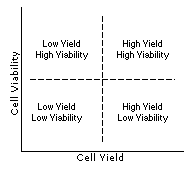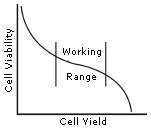
Worthington Tissue Dissociation GuideOptimization Techniques: General GuidelinesAlthough optimization of a cell isolation procedure for a particular cell type is dependent upon the adequate recovery of cells having various required characteristics, some guidelines can be established. The information in this guide regarding cell isolation and the enzymes used, when combined with logic and suitable experimental design, should lead to the development of a satisfactory cell isolation method. (See Freshney 1987 for a detailed discussion.)
The complex relationship between cell yield and viability can be represented by the simplified illustrations shown on the left. In general there is an area of optimized recovery balanced between yield and viability; working near the middle of this range will reduce variability in the results of the cell isolation procedure. Understanding this relationship and how it can vary with a particular cell type and application, can make the optimization process easier.
For troubleshooting purposes various possible results, along with suggested corrective actions are listed below. Keep in mind that there are no clear lines between the quadrants but rather converging zones with variable areas of overlap.
A scale showing the relative digestive power of the enzymes commonly used follows for reference. Refer to this scale when troubleshooting a dissociation and planning isolation strategy. Next: Optimization Strategy Tissue Tables (references, grouped by tissue type and species)Note: We have not limited the references listed to only those papers using Worthington enzymes. Generally speaking, the tissue dissociation enzymes offered by Worthington can be used interchangeably for most preparations cited. |

 Place Order
Place Order
